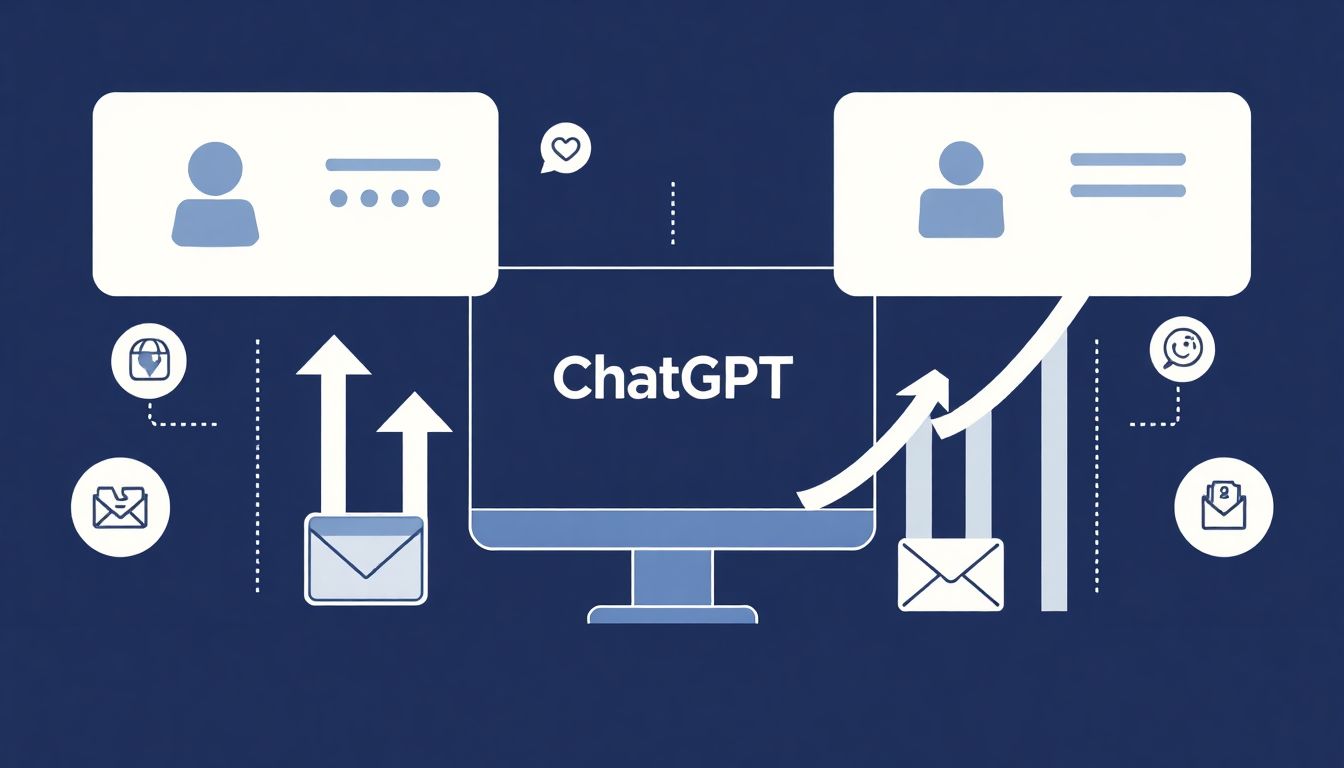If you’re struggling to boost your conversion rates, you’re not alone. Many businesses find it challenging to engage their customers and turn visits into sales. It can feel like running on a treadmill—working hard but not making real progress.
But don’t worry! If you stick around, I’ll share some super effective strategies using ChatGPT that can transform your approach and help you achieve those coveted conversions. With the right prompts and techniques, you can enhance user experience and skyrocket sales.
We’ll dive into everything from crafting effective ChatGPT prompts to optimizing your sales copy. So, let’s unlock the secrets to conversion rate optimization together!
Key Takeaways
- Using effective ChatGPT prompts can significantly boost your conversion rates and engage your audience better.
- Personalized interactions through ChatGPT enhance user engagement and help retain customers.
- Optimize sales copy and landing pages with tailored prompts to capture attention and drive conversions.
- Analyze customer feedback with specific prompts to extract actionable insights for improvement.
- Automate follow-up communications using ChatGPT to nurture leads and maintain customer relationships efficiently.
- Implement A/B testing on ChatGPT responses to discover which messages resonate most with your audience.

Effective ChatGPT Prompts for Boosting Conversion Rates
Using ChatGPT effectively can dramatically enhance your conversion rates.
Here are some prompts to get you started:
- “Generate five persuasive email subject lines for a limited-time offer on our new service.”
- “Write a sale announcement for our latest product that includes a strong call-to-action.”
- “Create a friendly chatbot response that guides a customer toward making a purchase.”
- “Develop a list of FAQs that address common customer concerns about our products.”
- “Draft an engaging social media post that highlights the benefits of our product and encourages shares.”
These prompts help you craft messages that resonate with your audience and drive them to take action.
Make sure to test and refine your prompts based on user feedback and interactions for even better results.
How ChatGPT Enhances User Engagement and Retention
ChatGPT plays a significant role in increasing user engagement and retention through personalized interactions.
By dynamically responding to user queries, it creates an interactive experience that keeps users coming back.
Consider these strategies:
- “Provide personalized product recommendations based on user behavior.”
- “Create a follow-up message after a purchase to thank customers and ask for feedback.”
- “Generate engagement questions for our social media posts that encourage audience interaction.”
By leveraging ChatGPT’s capabilities, you can build stronger relationships with your customers and keep them engaged longer.
Monitoring engagement metrics will help you understand what drives customer loyalty, allowing you to refine your strategies over time.
Leveraging ChatGPT for Personalized Customer Experiences
Personalization is key for creating meaningful customer experiences, and ChatGPT excels in this area.
Utilizing customer data, you can tailor interactions that resonate with individual preferences.
Here are some practical prompts you can use:
- “Craft a tailored welcome message for new customers based on their previous interactions.”
- “Generate a personalized birthday message with a special discount for loyal customers.”
- “Design segment-specific marketing messages for different user groups based on their shopping habits.”
By delivering tailored content, you can enhance the customer journey from the initial interaction to post-purchase follow-ups.
Remember, the more relevant the interaction, the higher the chances of turning a casual user into a loyal customer.
Using ChatGPT to Optimize Sales Copy and Landing Pages
Optimizing sales copy and landing pages is a vital step in boosting conversions, and ChatGPT can be your secret weapon.
Here are some actionable prompts for optimizing your copy:
- “Revise the following product description to make it more persuasive and compelling.”
- “Suggest three different CTAs for a landing page promoting our new service.”
- “Analyze the tone of this sales pitch and recommend adjustments for a friendlier approach.”
- “Draft an SEO-optimized headline for our latest blog post.”
These prompts are designed to help you create engaging, conversion-focused content that captures user attention.
Don’t forget to conduct A/B testing on your copy to see which versions perform better with your audience.
For more insights on using ChatGPT in various contexts, check out our posts on ChatGPT for Ecommerce and How to Use ChatGPT Prompts for Landing Page Copy.

ChatGPT Prompts for Analyzing Customer Feedback
Analyzing customer feedback is essential for refining products and services, and ChatGPT offers an efficient way to do this.
Here are some prompts you can use to gather insights on customer opinions:
- “Analyze the following customer feedback and summarize key themes and sentiments.”
- “Create a list of potential improvements based on this user feedback from our latest survey.”
- “Generate a sentiment analysis report for the comments on our product reviews page.”
- “Draft a follow-up question for customers who gave a low rating, aimed at understanding their specific concerns.”
- “Compile a positive feedback summary to highlight in our marketing materials.”
Using these prompts, you can transform raw feedback into actionable insights that help enhance customer satisfaction and loyalty.
Remember, insights gained from feedback analysis can inform your product development and marketing strategies effectively.
Automating Follow-Up Communications with ChatGPT
Follow-up communications are crucial for nurturing leads and maintaining customer relationships, and ChatGPT can automate this process.
Consider these prompts to streamline your follow-up messaging:
- “Craft a warm thank-you email for customers who made a recent purchase, including a request for their feedback.”
- “Generate a reminder message for customers who have items left in their shopping cart.”
- “Design a drip campaign outline for onboarding new customers with relevant tips and resources.”
- “Create a set of re-engagement emails for past customers who haven’t interacted with us in a while.”
- “Write a personalized follow-up message for customers who attended our recent webinar.”
By setting up these automated communications, you can save time while ensuring your customers feel valued and informed.
Make sure to review response metrics to tweak your messaging for optimal engagement as you go along.
Running A/B Tests on ChatGPT Responses
A/B testing is a powerful method to improve your interactions with customers, and ChatGPT can help facilitate these tests effectively.
Here’s how to create effective test prompts:
- “Draft two variations of a welcome message for new subscribers, focusing on different tones: one friendly and one professional.”
- “Generate two versions of a follow-up email after a demo, each emphasizing a different feature.”
- “Create alternative prompts for customer service inquiries that differ in length and detail.”
- “Write two distinct CTAs for our landing page: one direct and one value-driven.”
- “Propose two different subject lines for an email campaign to test open rates.”
Using these A/B test scenarios, you can evaluate which messaging resonates better with your audience.
Keep track of performance metrics to guide future interactions and improve overall engagement.

Best Practices for Integrating ChatGPT in Your Marketing Strategy
Integrating ChatGPT into your marketing strategy can significantly enhance customer interactions and drive conversions.
Start by defining clear goals. What do you want ChatGPT to achieve—improve customer support, enhance lead generation, or boost sales?
Next, choose the right platform for integration. Make sure it aligns with your existing marketing tools.
Use API capabilities to seamlessly connect ChatGPT with your CRM or email marketing systems.
Ensure that your ChatGPT model is trained with relevant data to provide context-aware responses.
Consider deploying ChatGPT across multiple channels: your website, social media, and email campaigns.
Don’t forget to monitor performance. Track user interactions to continually refine the responses and improve engagement.
Lastly, maintain a customer-first mindset, ensuring that every interaction feels personalized and valuable.
Here are some prompts to facilitate integration:
- “Outline a multi-channel strategy for deploying ChatGPT across our marketing efforts.”
- “Suggest ways to integrate ChatGPT with our existing CRM for better customer insights.”
- “Generate a list of potential use cases for ChatGPT in our email marketing campaigns.”
Measuring the Impact of ChatGPT on Conversion Rates
Measuring the impact of ChatGPT on conversion rates is essential to assess its effectiveness.
Start by defining your key performance indicators (KPIs). This could include metrics such as increased sales, lead conversion rates, or user engagement time.
Utilize analytics tools to gather data on user interactions with ChatGPT.
Track the conversion funnel to see where and how ChatGPT is influencing customer decisions.
Consider running A/B tests comparing traditional methods to those enhanced by ChatGPT insights.
Review feedback loops to understand user sentiment and satisfaction associated with ChatGPT interactions.
Here are some prompts for analysis:
- “Analyze the conversion rates before and after deploying ChatGPT to identify changes.”
- “Create a report summarizing user engagement metrics influenced by ChatGPT.”
- “Draft a presentation on the ROI of implementing ChatGPT in our marketing strategy.”
FAQs
Effective prompts should be clear and goal-oriented. Focus on specific user needs and outcomes, such as “How can I help you achieve your goals today?” to drive engagement and prompt meaningful interactions that enhance conversion rates.
ChatGPT fosters engagement through personalized interactions, addressing user queries directly. By providing relevant information and follow-ups, it helps retain users and keeps them coming back for quality service and tailored experiences.
Best practices include clearly defining objectives, training the model on relevant data, testing different prompts, and continually analyzing performance. User feedback should guide adjustments to enhance personalized engagement and effectiveness.
Track key performance indicators such as click-through rates, bounce rates, and overall conversion metrics before and after implementing ChatGPT. Use A/B testing to isolate effects and gather insights into user behavior changes.
